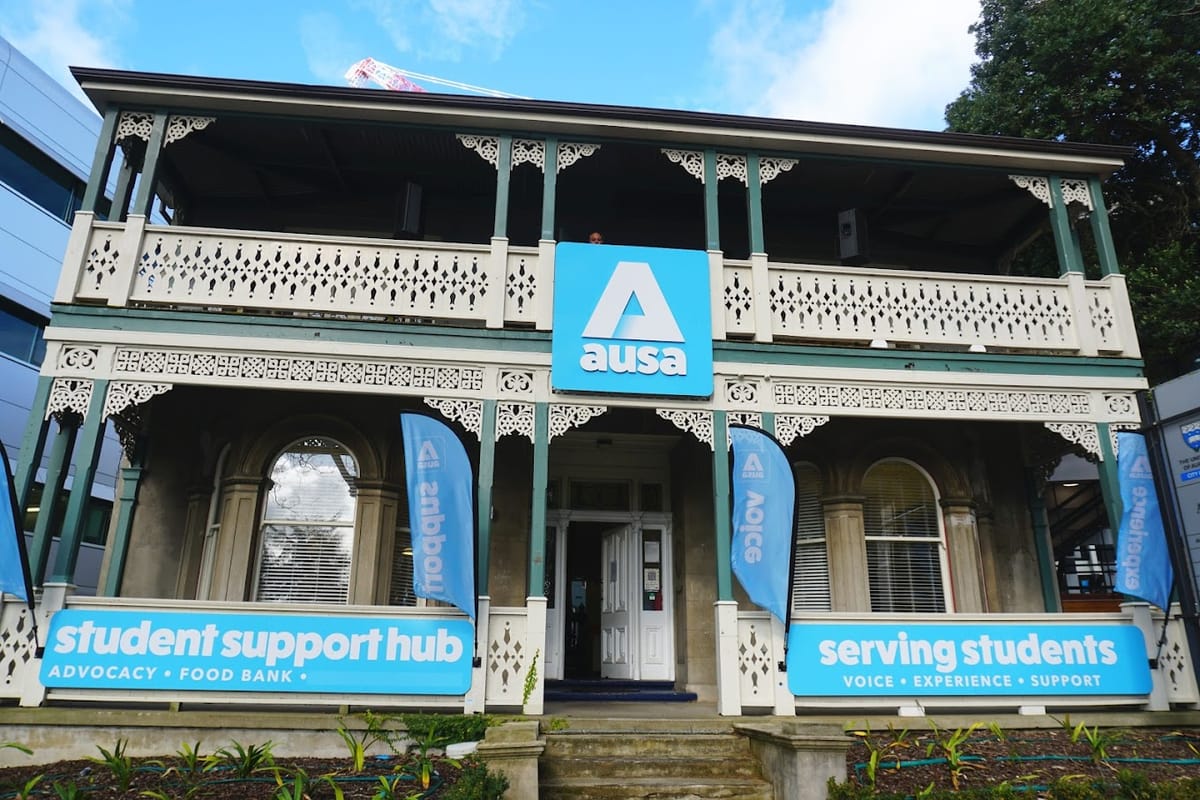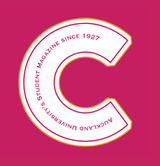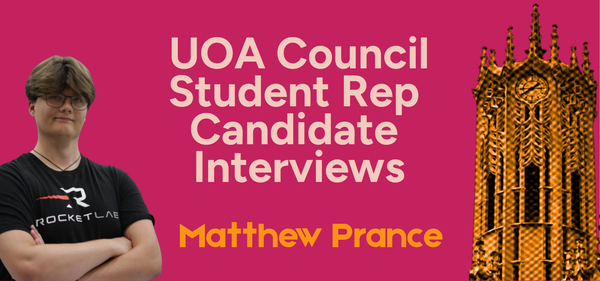On the Agenda: VC Recruitment and Craccum
What happened at the latest Student Council meeting? Read to find out...

6pm on Tuesday September 23rd. It was raining horrendously and I cried in the process of attempting to get parking on Princes Street, even though I’d arrived twenty minutes early. Luck, however, seemed to be on my side because I managed to make it to the latest Student Council meeting on time.
So what was the juicy agenda for the next two hours? Discussing recruitment efforts for the next Vice Chancellor, and… Craccum. I think five different people turned around to look at me when that was announced. Fair enough, there’s been a lot going on recently.
Vice Chancellor recruitment
The first hour of the meeting was dedicated to discussion about recruitment of a new Vice Chancellor. It was announced back in June that VC Dawn Freshwater was stepping down early from her role, starting a worldwide search for the University of Auckland’s next VC. Andrew Phipps, the director of Human Resources came in to speak about the next stages of recruitment, and also to ask council members of their thoughts on what qualities and attributes the next Vice Chancellor should have.
The recruitment process has apparently been quite difficult. The role of Vice Chancellor is an important one, with quite big shoes to fill. Phipps stated that they were currently looking in New Zealand and Australia for candidates, and that they were hoping to begin interviews towards the end of the year, with shortlisting ideally beginning around the same time, or at the start of 2026. At the end of the entire process, it will be up to the Council to make the final decision.
In regards to Phipps’ second question regarding potential attributes the new VC should have, the Student Council members had a wide range of thoughts.
One of the topics that seemed to come up the most when council members were sharing their thoughts was the idea that the University needs to start prioritising students. It’s not exactly a secret that The University of Auckland is run more like a business rather than an educational institution, and students said that this needs to change. Students suggested that instead of taking the current top-down approach to consulting with students and staff, that the next VC ensure that they are more engaged, and implement a bottom-up approach instead to ensure that the voice of everybody at the University is heard. AUSA Women’s Rights Officer Emelia Martin Moses shared that she felt the University was currently not taking their duty of care towards students seriously. Giving mental health and pastoral care as examples, she stated that the University needs to take action to show they care, rather than just offering students empty words.
Building on this topic, other students, especially those representing Arts faculties expressed the need for a VC who understands the importance of humanities subjects, and will protect them. This is coming after proposed budget cuts and course removals mainly targeted towards humanities subjects under VC Dawn Freshwater’s leadership. At the end of the day, the new VC needs to understand that the University’s main goal should be to educate, not to make profit.
Multiple students such as Matthew Lee, AUSA Undergradute Education Vice President, and Ronette Va’ai, AUSA Pacific Island Student’s Officer mentioned the significance of a VC who has cultural competence, and who understands Te Tiriti, manaakitanga, and the importance of being a good treaty partner. Ronette referred to situations this year regarding the WTR course and the Māori and Pasifika space that caused backlash from certain politicians, and firmly stated that the next VC should fight for, and protect these groups of students. Building onto this, Matthew expressed that he’d like to see somebody from Aotearoa, rather than Australia or the UK, as they would already be well versed with these cultural matters.
Other issues raised were that of more support for international students, acknowledgement and potential financial support for medical students on placements, and just general empathy towards all students and staff at the University.
Craccum
For the last hour of the meeting, Craccum’s Managing Editor Lewis Creed, and Digital Manager Lee Li came into the room (with Editor-in-Chief Harry Sutton joining online from the airport). They introduced themselves, and explained why they were there. To talk about Craccum’s recent campaign for independence from AUSA via an SGM, citing AUSA’s alleged lack of support for the magazine and several other factors as the reason. The atmosphere, to put it frankly, has not been good. An hour long stubborn debate thus ensued.
The editors' demands were mainly regarding the funding cuts that the magazine had endured both this year and is set to receive another blow again next year. As a result of the cut in budget for 2025, there were only ten print issues released, while the rest of Craccum’s content was published on a website, something that Lewis Creed mentioned had confused students. Craccum is a nearly 100-year-old print publication, and from 1970 up until this year, it had print issues released weekly.
In addition to this, Craccum lost the paid positions of Te Ao Māori Editor and Pasifika Editor. Craccum’s open letter, which was handed out at the beginning of the meeting to council members, asked for these two positions to be restored next year, citing AUSA’s duty to honour their commitment to Te Tiriti o Waitangi.
Finally, the Editors were concerned with a specific clause in the AUSA constitution regarding Craccum that, in their view, limits the magazine’s editorial independence. The clause states that Craccum has editorial independence to publish anything as long as it is consistent with rules and laws of New Zealand, and also doesn’t result in legal or reputational damage for AUSA.

Lewis Creed then reported his intentions to be a whistleblower, referring to leaked documents which had been handed out along with the open letter. To an echo of shocked laughter, he alleged that AUSA manager David Fulton was planning to “kill Craccum” or alternatively turn it into a propaganda mouthpiece, and that he’d also stood to gain a significant amount of money at the closing of UBIQ, the university’s beloved bookstore that shut down at the end of August. Lee Li also repeated claims of embezzlement or misplaced funds that were supposed to go to Craccum but were never received.
AUSA were given the opportunity to respond to these points. Both association president Gabriel Boyd and general manager David Fulton stated that their wishes were obviously for Craccum to continue and succeed, and that the concerns raised were valid. However, Fulton pointed out that AUSA was the worst-funded student association across universities in Aotearoa, and therefore had much more difficulty dividing up said funds into the many different categories and aspects of the university which needed attention. He also clarified that on the contrary, he had actually lost money from UBIQ’s closing.
Following this, Fulton pulled up slides with charts related to funding such as the CSSF pie chart that has been used by Craccum as evidence in this dispute. (Disclaimer, I am really bad with numbers and money-related matters so I did not understand every single aspect of this). He proceeded to explain that the numbers relating to each section of the pie chart were not exactly accurate, and neither were the names given to each section. There was a lot of overlap, and a lot of costs included in each of the sections that most people wouldn’t even think of. He also explained that in order to give Craccum more funding, funding would have to be reduced from another aspect of student life, from another section of the pie chart. Essentially, the CSSF was better to be viewed as a rough sketch of how everything was divided up, and not to be taken as evidence of mismanaged funds.
Regarding the less frequent print articles, Gabriel Boyd explained that the decision was actually made by the executive team last year, as they had thought that perhaps in this era of social media and the internet, Craccum would reach a wider audience if it went online. Both Boyd and Fulton indicated that this issue, as well as the concerns regarding editor positions and editorial independence could be spoken about further in order to address and resolve the situation. An estimated time for the SGM was also given, to been in Week 11 or 12.
Certain concerns brought up by Craccum such as the alleged plan to "kill" the magazine, or calls potential plans to revive the Te Ao Māori and Pasifika editor positions were not responded to.
An open discussion was then initiated, where other council members had the opportunity to ask questions or give their thoughts on the situation. Some members asked why the situation had escalated to this point, and whether there were attempts made to have discussions privately first. One member (who is apparently the Lorax) asked what Craccum was doing in order to be more sustainable. Valid, but a strange time to bring it up. Other members seemed to sympathise with Craccum’s concerns, and were more confused on the details of the SGM proposal, and what exactly independence would mean for Craccum, and for AUSA. Both sides agreed that the first proposal of the SGM was quite risky.
The one hour time limit of the meeting unfortunately meant that not everything could be discussed in detail, and the meeting ended with an air of unfinished business. Lingering in the air, however, was perhaps the hope for further meetings and discussions to hopefully address the confusions from both sides.





